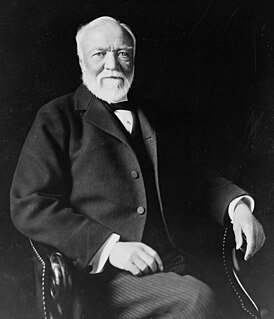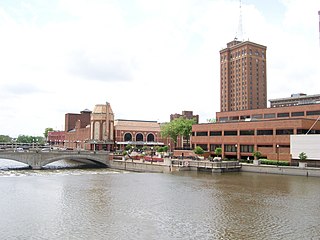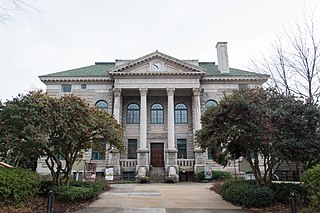
Decatur is a city in, and the county seat of, DeKalb County, Georgia that is part of the Atlanta metropolitan area. With a population of 20,148 in the 2013 census, the municipality is sometimes assumed to be larger since multiple ZIP Codes in unincorporated DeKalb County bear the Decatur name. The city is served by three MARTA rail stations. The city is located approximately 5 miles northeast of downtown Atlanta and shares its western border with Atlanta.

The Sycamore Historic District is a meandering area encompassing 99 acres (400,000 m2) of the land in and around the downtown of the DeKalb County, Illinois, county seat, Sycamore. The area includes historic buildings and a number of historical and Victorian homes. Some significant structures are among those located within the Historic District including the DeKalb County Courthouse and the Sycamore Public Library. The district has been listed on the National Register of Historic Places since May 2, 1978.

The Sycamore Public Library, in Sycamore, Illinois, was erected in 1905 in the former location of Mansion House, Sycamore's oldest structure. Construction began in May of that year and the library officially opened to the public on Thanksgiving Day, 1905. The library joined the National Register of Historic Places in May 1978 with the rest of the Sycamore Historic District. The library still operates, as of 2019, as the Sycamore library. The library was erected with the help of a $10,000 grant from Andrew Carnegie in 1905.

The D. B. James House is located in Sycamore, Illinois and is part of the Sycamore Historic District. The district was entered on the National Register of Historic Places in 1978. The James House is one of 226 properties located within the district boundaries. It stands on the corner of Exchange and Main Streets behind the DeKalb County Courthouse.

The U.S. Post Office in Sycamore, Illinois is listed on the National Register of Historic Places as part of the Sycamore Historic District. The district was designated and listed in May 1978. It stands directly across the street from another key structure in the district, the Sycamore Public Library and cross-corner from the district's largest structure, the DeKalb County Courthouse. It is open M-F from 8:30 am – 6:00 pm, Sat. from 9:00 am – 3:00 pm, and it is closed on Sunday.

The Frederick Townsend Garage is located in Sycamore, Illinois and is listed on the National Register of Historic Places as part of the Sycamore Historic District. It sits at the base of a small incline overlooked by the large Queen Anne style Townsend House. Last a gas station, the building has been used by a number of restaurants since then. It was restored and remodeled for use as a community bank in 2016. The Sycamore Historic District was listed on the Register in May 1978.
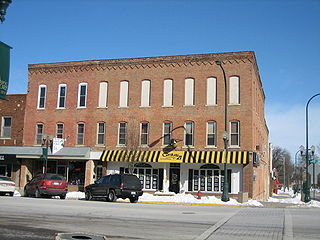
The George's Block, once known as the James Block, is a 19th-century structure located in Sycamore, Illinois, along Illinois Route 64 as it passes through the DeKalb County seat. The Block is part of the Sycamore Historic District and as such is listed on the National Register of Historic Places. The district joined the Register in May 1978. The building dates from 1857 when it was owned by Daniel P. James but by the 1860s the building has become known as George's Block.

The Charles O. Boynton House is located in the DeKalb County, Illinois, city of Sycamore. The home is part of the Sycamore Historic District which was designated and listed on the National Register of Historic Places in May 1978. The Queen Anne style mansion sits on a stretch of Sycamore's Main Street that is dotted with other significant Historic District structures including, the Townsend House and the Townsend Garage. The Boynton House was designed by the same architect who designed the Ellwood House in nearby DeKalb and the David Syme House, another house in the Sycamore Historic District.

The Civil War Memorial, in the DeKalb County county seat of Sycamore, Illinois, United States, is located in front of the DeKalb County Courthouse on a public square. The memorial was erected in 1896 and dedicated in 1897. The structure is a memorial to the thousands of DeKalb County residents who served in the American Civil War. It incorporates an obelisk which rises to 50 feet in height. The base is adorned with copper sculpture, completed by an unknown sculptor. On the east facade of the memorial the word "Antietam", denoting the Battle of Antietam, is misspelled. This work of public art underwent its first restoration work in 2005-2006.

The Chauncey Ellwood House is a 19th-century Italianate residence in the DeKalb County, Illinois city of Sycamore. It is a contributing property to the Sycamore Historic District; added to the National Register of Historic Places in 1978. The house is in the 800 block of Somonauk Street. The Esther Mae Nesbitt House, next door, was once the carriage house for the home.

The Carlos Lattin House was built by Illinois' first settler, Carlos Lattin. It lies within the boundaries of the Sycamore Historic District and is listed as one of the contributing structures in the district. The Sycamore Historic District was added to the National Register of Historic Places in 1978.

The Charles O. Boynton Carriage House is a prominent structure in the Sycamore Historic District, located in Sycamore, Illinois. The Sycamore Historic District was added to the National Register of Historic Places in 1978. The Carriage House is considered one of more than 150 contributing properties to the overall historic integrity of the district.

The Peter Johnsen Rooming House is an historic building near downtown Sycamore, Illinois. The red brick structure stands in the 100 block of South Main Street and is considered a contributing structure to the overall historic integrity of the Sycamore Historic District. The district was added to the National Register of Historic Places in May 1978.
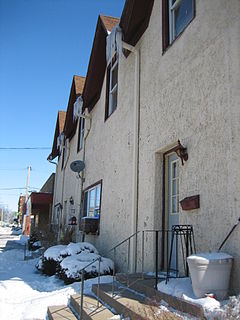
The Row Houses in Sycamore, Illinois are a small collection of historic terraced homes near the city's downtown. The building is considered by the National Register of Historic Places to be a contributing structure to the overall historic nature of the Sycamore Historic District. The district was added to the Register in May 1978. The buildings stand on the corner of Elm and California Streets in Sycamore.
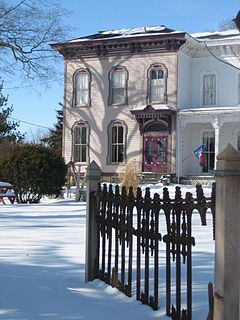
The houses in the Sycamore Historic District, in Sycamore, Illinois, United States, cross a variety of architectural styles and span from the 1830s to the early 20th century. There are 187 contributing properties within the historic district, 75% of the districts buildings. Many of the homes are associated with early Sycamore residents, usually prominent business leaders or politicians. Houses within the district are known by, either their street address or by a name associated with a prominent owner or builder. For most of the houses, the latter is true.

As of 2007 there are five church buildings in the Sycamore Historic District, located in Sycamore, Illinois, United States which are listed as contributing properties to the district. The Sycamore Historic District was added to the U.S. National Register of Historic Places on May 2, 1978. When it was nominated to join the National Register there were seven church buildings within the district. One of those included is a residential structure that was utilized as a church when it was first constructed; the Arthur Stark House was once home to the Sycamore Universalist Church congregation. In the time since its listing, two churches have been destroyed or demolished. The Evangelical Church of St. John was destroyed by fire in 2004 and the United Methodist Church in Sycamore is no longer extant, replaced by a modern office building.

The commercial buildings in the Sycamore Historic District, located in Sycamore, Illinois, United States are mostly located in and around the city's downtown. The largest concentration of commercial contributing properties to the historic district are found along Illinois Route 64 as it passes through Sycamore. They include several buildings known as "blocks" which can consist of more than one adjacent and attached structure, as is the case with the Waterman Block, one of the Sycamore commercial buildings.





